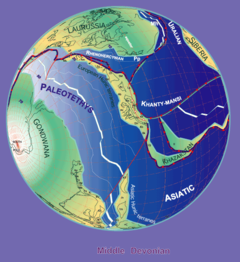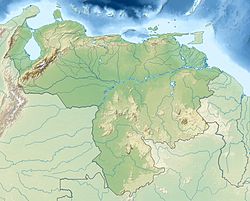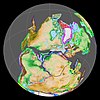Geological group in the Venezuelan Andes
Río Cachirí Group Type Geological group Unit of Cesar-Ranchería Basin , Serranía del Perijá Sub-units Caño Grande Fm. , Caño del Oeste Fm. , Campo Chico Fm. , Los Guineos Fm. Underlies Carboniferous sequence Overlies Perijá Formation Thickness ~1,100 m (3,600 ft) (Colombia) Primary Shale , sandstone Other Limestone Coordinates 10°50′03″N 72°14′23″W / 10.83417°N 72.23972°W / 10.83417; -72.23972 Region Cesar , La Guajira Zulia Country Colombia Venezuela Extent ~110 km (68 mi) (Venezuela) Named for Río Cachirí Named by Liddle Location Mara Year defined 1928 Coordinates 10°50′03″N 72°14′23″W / 10.83417°N 72.23972°W / 10.83417; -72.23972 Region Zulia Country Venezuela Thickness at type section 2,438 m (7,999 ft) by Stampfli & Borel
The Río Cachirí Group (Spanish : Grupo Río Cachirí , PZc) is a geological group of the Cesar-Ranchería Basin , Colombia and the Serranía del Perijá of the northernmost Colombian and Venezuelan Andes . The group of shales , sandstones and limestones is of Devonian age and has a maximum thickness in the Venezuelan section of 2,438 metres (7,999 ft). The group contains abundant fauna; crinoids , bryozoa , brachiopods and molluscs have been found in the group.
Etymology and definition
The formation was defined by Liddle in 1928 in Río Cachirí, part of Mara , Zulia , in the Venezuelan part of the Serranía del Perijá, and the same author subdivided the group into three formations in 1943. In 1972, Bowen added a fourth formation to the group.[ 1]
Description
Lithologies
The group contains black, grey and red shales , grey micaceous sandstones , quartzitic sandstones and red and bluish grey limestones .[ 1]
Stratigraphy and correlation
The Río Cachirí Group, dated to span the Devonian , is subdivided into the Caño Grande , Caño del Oeste , Campo Chico and Los Guineos Formations . The maximum thickness has been recorded in Venezuela, with 2,438 metres (7,999 ft), while the thickness on the Colombian side of the range does not exceed 1,100 metres (3,600 ft).[ 1] [ 2] unconformably overlies the Perijá Formation and is overlain by an unnamed Carboniferous sequence. The Río Cachirí Group is time-equivalent with the Floresta and Cuche Formations of the Floresta Massif, Altiplano Cundiboyacense and the Quetame Group of the Eastern Ranges .[ 3] epicontinental sea at the edge of the Paleo-Tethys Ocean .[ 1]
Fossil content
The group contains abundant fossils of crinoids , bryozoa , brachiopods and molluscs as Acrospirifer olssoni Spirifer kingi Leptaena boyaca Fenestella venezuelansis Neospirifer latus Composita subtilita Phricodrotis planoconvexa Pecten sp. [ 4]
Outcrops
Type locality of the Río Cachirí Group in Venezuela
Apart from its type locality on the eastern flank of the Serranía del Perijá in Zulia, Venezuela, the formation is also found in other parts of the mountain range, on the Colombian western side in the east of San Diego and Curumaní , Cesar .[ 5] [ 6]
Regional correlations
Stratigraphy of the Llanos Basin and surrounding provinces
Ma Age
Paleomap
Regional events Catatumbo Cordillera proximal Llanos
distal Llanos
Putumayo VSM Environments Maximum thickness Petroleum geology Notes
0.01 Holocene Holocene volcanismSeismic activity
alluvium
Overburden
1 Pleistocene Pleistocene volcanismAndean orogeny 3Glaciations
Guayabo Soatá Sabana Necesidad Guayabo Gigante Alluvial to fluvial (Guayabo)550 m (1,800 ft) [ 7] [ 8] [ 9] [ 10]
2.6 Pliocene Pliocene volcanism Andean orogeny 3GABI Subachoque
5.3 Messinian Andean orogeny 3Foreland Marichuela Caimán Honda [ 9] [ 11]
13.5 Langhian Regional flooding
León hiatus Caja León Lacustrine (León)400 m (1,300 ft) Seal [ 10] [ 12]
16.2 Burdigalian Miocene inundationsAndean orogeny 2
C1 Carbonera C1 Ospina Proximal fluvio-deltaic (C1)
850 m (2,790 ft) Reservoir [ 11] [ 10]
17.3 C2 Carbonera C2 Distal lacustrine-deltaic (C2)
Seal
19 C3 Carbonera C3 Proximal fluvio-deltaic (C3)
Reservoir
21 Early Miocene Pebas wetlands C4 Carbonera C4 Barzalosa Distal fluvio-deltaic (C4)
Seal
23 Late Oligocene Andean orogeny 1Foredeep C5 Carbonera C5 Orito Proximal fluvio-deltaic (C5)
Reservoir [ 8] [ 11]
25 C6 Carbonera C6 Distal fluvio-lacustrine (C6)
Seal
28 Early Oligocene C7 C7 Pepino Gualanday Proximal deltaic-marine (C7)
Reservoir [ 8] [ 11] [ 13]
32 Oligo-Eocene
C8 Usme C8 onlap Marine-deltaic (C8)
Seal Source [ 13]
35 Late Eocene Mirador Mirador Coastal (Mirador)
240 m (790 ft) Reservoir [ 10] [ 14]
40 Middle Eocene Regadera hiatus
45
50 Early Eocene Socha Los Cuervos Deltaic (Los Cuervos)
260 m (850 ft) Seal Source [ 10] [ 14]
55 Late Paleocene PETM 2000 ppm CO2 Los Cuervos Bogotá Gualanday
60 Early Paleocene SALMA Barco Guaduas Barco Rumiyaco Fluvial (Barco)
225 m (738 ft) Reservoir [ 7] [ 8] [ 11] [ 10] [ 15]
65 Maastrichtian KT extinction Catatumbo Guadalupe Monserrate Deltaic-fluvial (Guadalupe)
750 m (2,460 ft) Reservoir [ 7] [ 10]
72 Campanian End of rifting Colón-Mito Juan [ 10] [ 16]
83 Santonian Villeta /Güagüaquí
86 Coniacian
89 Turonian Cenomanian-Turonian anoxic event La Luna Chipaque Gachetá hiatus Restricted marine (all)
500 m (1,600 ft) Source [ 7] [ 10] [ 17]
93 Cenomanian Rift 2
100 Albian Une Une Caballos Deltaic (Une)500 m (1,600 ft) Reservoir [ 11] [ 17]
113 Aptian Capacho Fómeque Motema Yaví Open marine (Fómeque)
800 m (2,600 ft) Source (Fóm)[ 8] [ 10] [ 18]
125 Barremian High biodiversity Aguardiente Paja Shallow to open marine (Paja)
940 m (3,080 ft) Reservoir [ 7]
129 Hauterivian Rift 1 Tibú- Las Juntas hiatus Deltaic (Las Juntas)910 m (2,990 ft) Reservoir (LJun)[ 7]
133 Valanginian Río Negro Cáqueza Macanal Rosablanca Restricted marine (Macanal)
2,935 m (9,629 ft) Source (Mac)[ 8] [ 19]
140 Berriasian Girón
145 Tithonian Break-up of Pangea Jordán Arcabuco Buenavista Saldaña Alluvial , fluvial (Buenavista)110 m (360 ft) "Jurassic"
[ 11] [ 20]
150 Early-Mid Jurassic Passive margin 2 La Quinta Noreán hiatus Coastal tuff (La Quinta)
100 m (330 ft) [ 21]
201 Late Triassic Mucuchachi Payandé [ 11]
235 Early Triassic Pangea hiatus "Paleozoic"
250 Permian
300 Late Carboniferous Famatinian orogeny Cerro Neiva () [ 22]
340 Early Carboniferous Fossil fish Romer's gap Cuche (355-385) Farallones () Deltaic , estuarine (Cuche)900 m (3,000 ft)
360 Late Devonian Passive margin 1 Río Cachirí (360-419) Ambicá () Alluvial -fluvial -reef (Farallones)2,400 m (7,900 ft) [ 19] [ 23] [ 24] [ 25] [ 26]
390 Early Devonian High biodiversity Floresta (387-400) Shallow marine (Floresta)
600 m (2,000 ft)
410 Late Silurian Silurian mystery
425 Early Silurian hiatus
440 Late Ordovician Rich fauna in Bolivia San Pedro (450-490) Duda ()
470 Early Ordovician First fossils Busbanzá (>470±22 ) Guape () Río Nevado () [ 27] [ 28] [ 29]
488 Late Cambrian Regional intrusions
Chicamocha (490-515) Quetame () Ariarí () SJ del Guaviare (490-590) San Isidro () [ 30] [ 31]
515 Early Cambrian Cambrian explosion [ 29] [ 32]
542 Ediacaran Break-up of Rodinia pre-Quetame post-Parguaza El Barro () Yellow: allochthonous basementChibcha terrane )Río Negro-Juruena Province )
Basement [ 33] [ 34]
600 Neoproterozoic Cariri Velhos orogeny Bucaramanga (600-1400) pre-Guaviare [ 30]
800 Snowball Earth [ 35]
1000 Mesoproterozoic Sunsás orogeny Ariarí (1000) La Urraca (1030-1100) [ 36] [ 37] [ 38] [ 39]
1300 Rondônia-Juruá orogeny pre-Ariarí Parguaza (1300-1400) Garzón (1180-1550) [ 40]
1400 pre-Bucaramanga [ 41]
1600 Paleoproterozoic Maimachi (1500-1700) pre-Garzón [ 42]
1800 Tapajós orogeny Mitú (1800) [ 40] [ 42]
1950 Transamazonic orogeny pre-Mitú [ 40]
2200 Columbia
2530 Archean Carajas-Imataca orogeny [ 40]
3100 Kenorland
Sources
Legend group important formation fossiliferous formation minor formation (age in Ma) proximal Llanos (Medina)[ note 1]
distal Llanos (Saltarin 1A well)[ note 2]
See also
Geology of the Eastern Hills Geology of the Ocetá Páramo Geology of the Altiplano Cundiboyacense
Notes
^ based on Duarte et al. (2019)[ 43] [ 44] [ 45]
^ based on Duarte et al. (2019)[ 43] UIS and ANH in 2009[ 46]
References
^ a b c d Ayala, 2009, p.20
^ Hernández Ferrer, 2011, p.47
^ Ayala, 2009, p.21
^ García González et al., 2007, p.68
^ Plancha 34, 2007
^ Plancha 48, 2008
^ a b c d e f García González et al., 2009, p.27
^ a b c d e f García González et al., 2009, p.50
^ a b García González et al., 2009, p.85
^ a b c d e f g h i j Barrero et al., 2007, p.60
^ a b c d e f g h Barrero et al., 2007, p.58
^ Plancha 111, 2001, p.29
^ a b Plancha 177, 2015, p.39
^ a b Plancha 111, 2001, p.26
^ Plancha 111, 2001, p.24
^ Plancha 111, 2001, p.23
^ a b Pulido & Gómez, 2001, p.32
^ Pulido & Gómez, 2001, p.30
^ a b Pulido & Gómez, 2001, pp.21-26
^ Pulido & Gómez, 2001, p.28
^ Correa Martínez et al., 2019, p.49
^ Plancha 303, 2002, p.27
^ Terraza et al., 2008, p.22
^ Plancha 229, 2015, pp.46-55
^ Plancha 303, 2002, p.26
^ Moreno Sánchez et al., 2009, p.53
^ Mantilla Figueroa et al., 2015, p.43
^ Manosalva Sánchez et al., 2017, p.84
^ a b Plancha 303, 2002, p.24
^ a b Mantilla Figueroa et al., 2015, p.42
^ Arango Mejía et al., 2012, p.25
^ Plancha 350, 2011, p.49
^ Pulido & Gómez, 2001, pp.17-21
^ Plancha 111, 2001, p.13
^ Plancha 303, 2002, p.23
^ Plancha 348, 2015, p.38
^ Planchas 367-414, 2003, p.35
^ Toro Toro et al., 2014, p.22
^ Plancha 303, 2002, p.21
^ a b c d Bonilla et al., 2016, p.19
^ Gómez Tapias et al., 2015, p.209
^ a b Bonilla et al., 2016, p.22
^ a b Duarte et al., 2019
^ García González et al., 2009
^ Pulido & Gómez, 2001
^ García González et al., 2009, p.60
Bibliography
Ayala Calvo, Rosa Carolina (2009), Análisis tectonoestratigráfico y de procedencia en la Subcuenca de Cesar: Relación con los sistemas petroleros (MSc. thesis) (PDF) , Universidad Simón Bolívar , pp. 1– 255, retrieved 2017-06-14 García González, Mario; Mier Umaña, Ricardo; Cruz Guevara, Luis Enrique; Vásquez, Mauricio (2009), Informe Ejecutivo - evaluación del potencial hidrocarburífero de las cuencas colombianas , Universidad Industrial de Santander , pp. 1– 219 Hernández Ferrer, Mauricio Esteban (2011), Actualización de la geología de superficie en la Sierra de Perijá mediante la utilización de imágenes satelitales (PDF) , Simón Bolívar University, pp. 1– 125, retrieved 2017-08-03
Maps
Colmenares, Fabio; Mesa, Milena; Roncancio, Jairo; Arciniegas, Edgar; Pedraza, Pablo; Cardona, Agustín; Silva, César; Romero, Jhoamna; Alvarado and Oscar Romero, Felipe Vargas, Carlos Santamaría, Sonia (2007), Plancha 34 - Agustín Codazzi - 1:100,000 INGEOMINAS , p. 1, retrieved 2017-06-14 {{citation }}: CS1 maint: multiple names: authors list (link )Hernández, Marina; Clavijo, Jairo (2008), Plancha 48 - La Jagua de Ibirico - 1:100,000 INGEOMINAS , p. 1, retrieved 2017-06-14


























